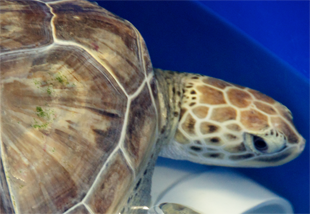Posted by Rick Civelli | 02.17.2012 | Turtle Talk
De-listing the Hawaiian Green Turtle
Tuesday marked an interesting day in sea turtle conservation. The Association of Hawaiian Civic Clubs (AOHCC) filed a petition with the federal government to classify the green turtles found around Hawaii as a distinct population segment. To do so, however, the Hawaiian green turtle would need to be removed from the Endangered Species Act.
 Proponents of the petition have some scientific support for their cause. Honu, as the Hawaiian green turtle is locally known, have strong nesting success. Since the 1970s, the nesting population has been increasing an average of 5.7% each year. These green sea turtles nest in the Hawaiian Islands, most within the Papahānaumokuākea Marine National Monument (an area the size of California). Adults also seem to remain in the area of the volcanic island chain.
Proponents of the petition have some scientific support for their cause. Honu, as the Hawaiian green turtle is locally known, have strong nesting success. Since the 1970s, the nesting population has been increasing an average of 5.7% each year. These green sea turtles nest in the Hawaiian Islands, most within the Papahānaumokuākea Marine National Monument (an area the size of California). Adults also seem to remain in the area of the volcanic island chain.
Sea turtles in general are a highly migratory species, traveling through many different waters. For many years their juvenile life remained a mystery. They were seen crawling from a nest, then seemingly vanished, only to return years later as mature adults. Green turtles are also extremely slow in maturing, sometimes not reaching maturity until 35-40 years of age. As a species, the green sea turtle is threatened throughout its range, with the exception of Florida and Mexico’s Pacific Coast – where they are endangered.
The delisting of the honu would not leave it unprotected. Management would transfer to Hawaii. AOHCC Preseident Soulee Stroud has said, “This would be wonderful to bring the management of this important cultural animal back to the people of Hawaii.” Since the honu has cultural and religious significance in Hawaii, there is no doubt that they would work hard to protect them, but could this open a dangerous precedent? Should a migratory species be broken into distinct population segments?



 Marine Bio
Marine Bio SCUBA
SCUBA Travel
Travel School Groups
School Groups Sign Up
Sign Up CONTACT
CONTACT CAMPS
CAMPS ABOUT
ABOUT